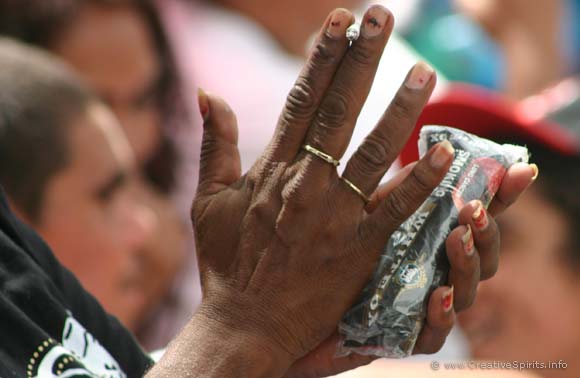The new drive to reduce smoking in Aboriginal communities

A new scheme is set to launch in 30 health services across Australia with the challenging aim of helping Aboriginal and Torres Strait Islander women not only understand the dangers of smoking during pregnancy, but to ultimately quit for good.
Whilst Australia on the whole is leading the way in terms of low prevalence of tobacco usage, with only around 13 per cent of adults smoking, the country’s Aboriginal and Torres Strait Islander population remains disproportionately affected by smoking, with 40 per cent among Aboriginal and Torres Strait Islander people and 45 per cent Indigenous pregnant women classed as smokers.
This unfortunately reflects a wider trend in Australian health outcomes, with a long-standing dichotomy between the country’s Aboriginal population and everyone else. However, in recent years there has been a concerted effort to ‘close the gap’, and one of the biggest factors to be targeted has been tobacco smoking.
As noted by NSW Health, smoking has, over time, become commonplace in Aboriginal communities. It should be remembered that smoking is not a traditional part of Aboriginal culture but was introduced and later became a part of the rations given by white people.
The reasons for the high smoking rates among Aboriginal people are complex. They include being exposed to smoking early in life and living in a community where smoking is ‘the social norm’ and social disadvantage such as living in poverty, leaving school early and unemployment.
Other drivers include smoking to cope with life stressors such as housing stress, mental illness, alcohol and other drug use, grief and loss and a culture of sharing, often involving tobacco products.
Smoking has, over time, become commonplace in Aboriginal communities. It should be remembered that smoking is not a traditional part of Aboriginal culture but was introduced and later became a part of the rations given by white people.
Aboriginal smokers consume more cigarettes – 147 a week on average – than non aboriginal smokers – 101 – and are less likely to quit. Smoking related cancers are three times more common in Aboriginal communities than the rest of the population. Aboriginal people are 70% more likely than other Australians to develop lung cancer, with 2 aboriginals being diagnosed every day,
Associate Professor Gillian Gould of the University of Newcastle in Australia, is leading a new initiative to offer Indigenous women both guidance and practical help to quit smoking for good.
Whilst Gould acknowledges that health professionals have done their utmost to draw attention to the health issues surrounding tobacco usage during pregnancy and have tried to offer brief advice to help women quit smoking, they have had neither the resources or confidence to make a sufficient impact.
Many Indigenous pregnant women thus receive mixed messages, and often believe that cutting back is enough. They are often out of reach of public health and TV information campaigns.
As well as causing harm to themselves, including a greater chance of cervical cancer, smoking harms the unborn child. When pregnant women smoke, they inhale carbon monoxide, which reduces the amount of oxygen their baby receives and in turn causes a trail of health problems even before it is born.
These health issues include an increased risk of ‘glue ear’, which causes hearing loss, learning problems and behavioural problems, as well as a greater risk of asthma and bronchiolitis and chronic lung disease in adulthood.
Children of women who smoke in pregnancy are also more likely to become smokers themselves. Indeed, some try smoking as young as five years old. This increases their risk of heart attack or stroke as they grow up and a 10 to 15% higher risk of developing coronary disease as adults. Even if children do not smoke themselves, they are at risk from passive smoking in overcrowded accommodation.
Warren Snowdon, a former Indigenous Health Minister, argues that “if we could reduce tobacco consumption levels in the Aboriginal and Torres Strait Islander community to what it is in the general population we could increase life expectancy by between 4 and 5 years.”
The SISTAQUIT (Supporting Indigenous Smokers To Assist Quitting) in Pregnancy project is taking a new approach, targeting Aboriginal Medical Services as a way to help people stop smoking, in the belief that this more targeted approach will have more impact than previous more generalised health support.
Gould and her team have also put together a novel set of training tools to aid them in getting their message across. Using instructive webinars and video resources, the team believe these offer an effective, efficient and cost-effective way of getting key messages across, especially in rural and remote areas.
One video features Aboriginal obstetrician Dr Marilyn Clarke explaining in very basic and easy to understand terms, why smoking is bad for unborn babies, whilst delving deeper into the issues than simply citing low birth weight.
From a practical standpoint however, SISTAQUIT isn’t simply about lecturing on the perils of smoking, but also offers the women practical aids to quitting, such as oral forms of nicotine replacement therapy (NRT), which are not currently subsidised in Australia, and help to make a quit plan taking into account the women’s individual psychosocial circumstances.
Health professionals will be encouraged to follow up the pregnant women, and make sure she has all the help she and her family need to go smoke-free.
The team are currently recruiting the final few health services needed to undertake SISTAQUIT’s largest trial yet, but Gould has already received positive feedback.
‘We have heard from our pilot study that it has helped the health services and it’s gone beyond just the women who are signing up to be participants in the project. Other women are quitting. It’s having this ripple effect, which is something we didn’t really appreciate.’
You can read the full Science Impact article here.

Open Forum is a policy discussion website examining the social, political, economic, cultural and environmental issues of today. We welcome contributions and invite you to follow us on Twitter, Linkedin, Federated Press and Vivaldi Social. We #StandwithUkraine.













